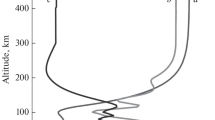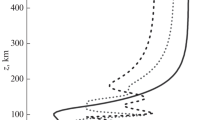Abstract
The generation and propagation of waves from model tropospheric meteorologic heat sources are theoretically studied. The processes of gas heating/cooling in water phase transitions at tropospheric altitudes are assumed to be the wave sources. In an analytical part of the study, equations are derived which describe the generation and propagation of acoustic and internal gravity waves separately. It is shown that powers of partial sources of acoustic and internal gravity waves always approximately coincide, regardless of wave frequencies, and the generation of internal gravity waves cannot occur without the generation of acoustic waves, and vice versa. Explicit analytical expressions are obtained for the generated waves. Due to resonant properties of the atmosphere, the high-frequency sources generate predominantly acoustic waves. The low-frequency sources generate mainly internal gravity waves if the sources work long enough for the resonance properties of atmosphere to be manifested. Using numerical experiments, the issue of error is investigated which is introduced if a tropospheric source is replaced with a surface one in which the pressure fluctuations on the surface are the recorded pressure fluctuations caused by the tropospheric source. It is shown that, if a tropospheric source operates at the infrasonic wave frequencies, then the wave patterns generated in the upper atmosphere from the tropospheric source and from the surface pressure fluctuations are almost identical. In the case of a tropospheric source operating at frequencies of internal gravity waves, the amplitude of waves from the surface pressure may be overestimated no more than twice. It is shown that, based on pressure fluctuations on the Earth’s surface, some corrected surface pressure source can be constructed which takes into account the phase shifts of interfering waves that propagate into the upper atmosphere. This provides a significant improvement in the simulation of waves from meteorological sources based on data on atmospheric pressure fluctuations.







Similar content being viewed by others
REFERENCES
D. C. Fritts, S. L. Vadas, K. Wan, and J. A. Werne, “Mean and variable forcing of the middle atmosphere by gravity waves,” J. Atmos. Sol.-Terr. Phys. 68, 247–265 (2006).
R. Ploogonven and Ch. Snyder, “Inertial gravity waves spontaneously generated by jets and fronts. Part I: Different baroclinic life cycles,” J. Atmos. Sci. 64, 2502–2520 (2007).
R. Plougonven and F. Zhang, “Internal gravity waves from atmospheric jets and fronts,” Rev. Geophys. 52, 1–37 (2014).
M. A. Chernigovskaya, E. N. Sutyrina, and K. G. Ratovskii, “Meteorological effects of ionospheric disturbance over Irkutsk according to vertical radiosounding data,” Sovrem. Probl. Distantsionnogo Zondirovaniya Zemli Kosmosa 11 (2), 264–274 (2014).
O. Borchevkina, I. Karpov, and M. Karpov, “Meteorological storm influence on the ionosphere parameters,” Atmosphere 11 (9), 1017 (2020). https://doi.org/10.3390/atmos11091017
J. Boška, P. Šauli, J. German Solé, and L. F. Alberca, “Diurnal variation of the gravity wave activity at midlatitudes of the ionospheric F region,” Stud. Geophys. Geodaet. 47 (3), 579–586 (2003). https://doi.org/10.1023/A:1024763618505
A. Ebel, “Contributions of gravity waves to the momentum, heat and turbulent energy budget of the upper mesosphere and lower thermosphere,” J. Atmos. Terr. Phys. 46, 727–737 (1984). https://doi.org/10.1016/0021-9169(84)90054-0
M. J. Alexander and L. Pfister, “Gravity wave momentum flux in the lower stratosphere over convection,” Geophys. Res. Lett. 22 (15), 2029–2032 (1995).
S. P. Kshevetskii and N. M. Gavrilov, “Vertical propagation, breaking, and effects of nonlinear gravity waves in the atmosphere,” J. Atmos. Sol.-Terr. Phys. 67, 10141030 (2005).
I. Karpov and S. Kshevetskii, “Numerical study of heating the upper atmosphere by acoustic-gravity waves from a local source on the Earth’s surface and influence of this heating on the wave propagation conditions,” J. Atmos. Sol.-Terr. Phys. 164, 1016 (2017). https://doi.org/10.1016/j.jastp.2017.07.019
J. B. Snively and V. B. Pasko, “Breaking of thunderstorm-generated gravity waves as a source of short-period ducted waves at mesopause altitudes,” Geophys. Rev. Lett. 30 (24), 2254 (2003). https://doi.org/10.1029/2003GL018436
M. Klimenko, F. S. Bessarab, T. V. Sukhodolov, et al., “Ionospheric effects of the sudden stratospheric warming in 2009: Results of simulation with the first version,” 12, 760–770 (2018). https://doi.org/10.1134/S1990793118040103
G. I. Grigor’ev, “Acoustic-gravity waves in the earth’s atmosphere (review),” Radiophys. Quantum Electron. 42 (1), 1–21 (1999).
A. V. Koval’ and N. M. Gavrilov, “Parametrization of the influence of orographic waves on the general circulation of the middle and upper atmosphere,” Uch. Zap. Ross. Gos. Gidrometeorol. Univ. 20, 71–75 (2011).
J. Artru, V. Ducic, H. Kanamori, et al., “Ionospheric detection of gravity waves induced by tsunamis,” Geophys. J. Int. 160, 840–848 (2005). https://doi.org/10.1134/10.1111/j.1365-246X.2005.02552.x
A. Bourdillon, G. Occhipinti, J.-P. Molnié, and V. Rannou, “HF radar detection of infrasonic waves generated in the ionosphere by the 28 March 2005 Sumatra earthquake,” J. Atmos. Sol.-Terr. Phys. 109, 75–79 (2014). https://doi.org/10.1016/j.jastp.2014.01.008
J. Chum, K. Skripnikova, and J. Base, “Atmospheric infrasound observed during intense convective storms on 9–10 July 2011,” J. Atmos. Sol. Terr. Phys. 122, 66–74 (2015). https://doi.org/10.1016/j.jastp.2014.10.014
E. Blanc, T. Farges, A. Le Pichon, et al., “Ten year observations of gravity waves from thunderstorms in western Africa,” J. Geophys. Res.: Atmos. 119, 6409–6418 (2014).
A. D. Pierce and S. C. Coroniti, “A mechanism for the generation of acoustic-gravity waves during thunder-storm formation,” Nature 210, 1209–1210 (1966).
Y. Kurdyaeva, S. Kulichkov, S. Kshevetskii, et al., “Propagation to the upper atmosphere of acoustic-gravity waves from atmospheric fronts in the Moscow region,” Ann. Geophys. 37 (3), 447–454 (2019). https://doi.org/10.5194/angeo-37-447-2019
Yu. A. Kurdyaeva, S. N. Kulichkov, S. P. Kshevetskii, et al., “Vertical propagation of acoustic-gravity waves from atmospheric fronts into the upper atmosphere,” Izv., Atmos. Ocean. Phys. 55 (4), 303–311 (2019). https://doi.org/10.1134/S0001433819040078
S. Kshevetskii, Y. Kurdyaeva, S. Kulichkov, et al., “Simulation of propagation of acoustic-gravity waves generated by tropospheric front instabilities into the upper atmosphere,” Pure Appl. Geophys. 177, 5567–5584 (2020). https://doi.org/10.1007/s00024-020-02569-y
Yu. A. Kurdyaeva, S. P. Kshevetskii, N. M. Gavrilov, et al., “Well-posedness of a problem of propagation of nonlinear acoustic-gravity waves in the atmosphere generated by surface pressure variations,” Num. Anal. Appl. 10 (4), 324–338 (2017).
Y. A. Kurdyaeva, S. P. Kshevetskii, N. M. Gavrilov, et al., “Correct boundary conditions for the high-resolution model of nonlinear acoustic-gravity waves forced by atmospheric pressure variations,” Pure Appl. Geophys. 175, 3639–3652 (2018). https://doi.org/10.1007/s00024-018-1906-x
Kh. P. Pogosyan, Cyclones (Gidrometeoizdat, Leningrad, 1976) [in Russian].
J. M. Wallace and P. V. Hobbs, Atmospheric Science: An Introductory Survey (Academic Press, New York, 2006).
S. P. Kshevetskii, “Modeling of propagation of internal gravity waves in gases,” Comput. Math. Math. Phys. 41 (2), 273–288 (2001).
E. E. Gossard and W. H. Hooke, Waves in the Atmosphere (Elsevier, Amsterdam, 1975; Mir, Moscow, 1978).
AtmoSym Model of Atmospheric Processes, 2016. http://atmos.kantiana.ru. Accessed March 14, 2021.
J. M. Picone, A. E. Hedin, D. P. Drob, et al., “NRLMSISE-00 empirical model of the atmosphere: statistical comparisons and scientific Issues,” J. Geophys. Res. 107 (A12), 1468 (2002). https://doi.org/10.1029/2002JA009430
S. P. Kshevetskii, “On long acoustic-gravity waves in the atmosphere with arbitrary stratification by density,” Izv. Ross. Akad. Nauk: Fiz. Atmos. Okeana 28 (5), 558–559 (1992).
Yu. V. Brezhnev, S. P. Kshevetskii, and S. B. Leble, “Liner initialization of hydrodynamical fields,” Izv. Ross. Akad. Nauk: Fiz. Atmos. Okeana 30 (1), 86–90 (1994).
S. P. Kshevetskii, “Quasi-waveguide modes of internal gravity waves in the atmosphere,” Izv., Atmos. Ocean. Phys. 39 (2), 217–227 (2003).
Ya. Drobzheva and V. Krasnov, “The acoustic field in the atmosphere and ionosphere caused by a point explosion on the ground,” J. Atmos. Sol.-Terr. Phys. 65 (3), 369–377 (2003).
D. V. Miller, “Thunderstorm induced gravity waves as a potential hazard to commercial aircraft,” in Proceedings of the 79th Annual Conference of the American Meteorological Society (American Meteorological Society, 1999).
R. Fovell, D. Durran, and J. R. Holton, “Numerical simulation of convectively generated stratospheric gravity waves,” J. Atmos. Sci. 49 (16), 1427–1442 (1992).
S. P. Kshevetskii and S. N. Kulichkov, “Effects that internal gravity waves from convective clouds have on atmospheric pressure and spatial temperature-disturbance distribution,” Izv., Atmos. Ocean. Phys. 51 (1), 42–48 (2015).
Funding
The work was supported by the Russian Science Foundation grant no. 21-17-00208 (Yu. A. Kurdyaeva: sections 2, 3, 4) and no. 21-17-00021 (S.N. Kulichkov section 1, 5). Sections 1-6 were completed by S. P. Kshevetskii.
Author information
Authors and Affiliations
Corresponding author
Ethics declarations
The authors declare that they have no conflict of interest.
Additional information
Translated by M. Samokhina
Rights and permissions
About this article
Cite this article
Kshevetskii, S.P., Kurdyaeva, Y.A. & Kulichkov, S.N. Studying Specific Features of the Propagation of Atmospheric Waves Generated by Tropospheric Sources and Variations in the Surface Pressure. Izv. Atmos. Ocean. Phys. 58, 30–43 (2022). https://doi.org/10.1134/S0001433822010066
Received:
Revised:
Accepted:
Published:
Issue Date:
DOI: https://doi.org/10.1134/S0001433822010066




